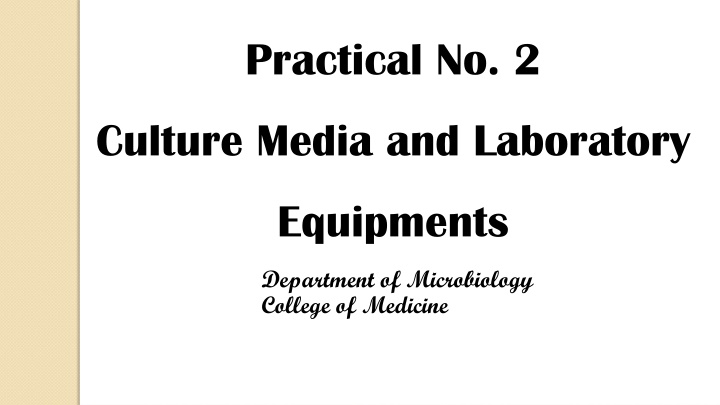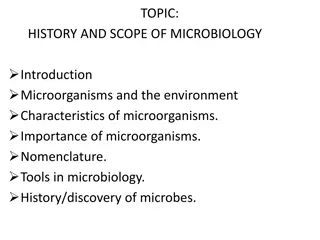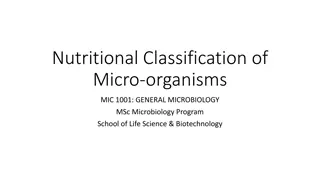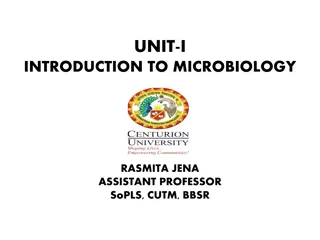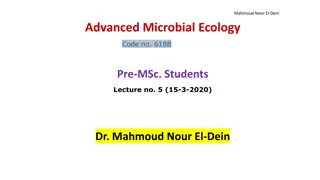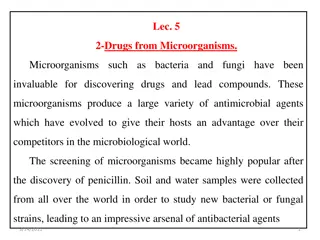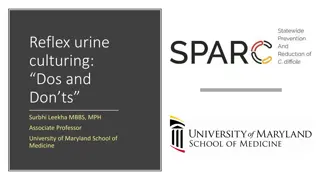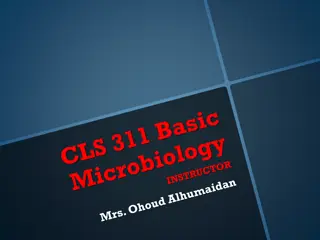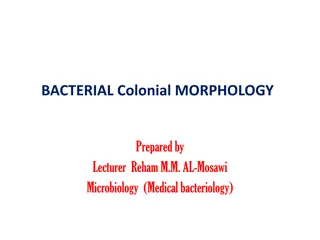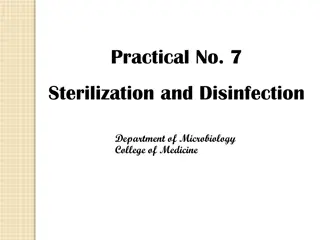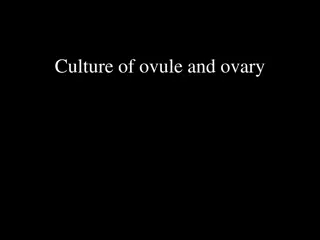Microbiology Practical: Culturing Microorganisms for Identification
The Department of Microbiology at the College of Medicine emphasizes the importance of understanding the microscopic morphology and staining characteristics of microorganisms in clinical specimens. By providing suitable culture media rich in nutrients essential for growth, microbiologists can identify and study microorganisms effectively. This exercise involves preparing nutrient broth and agar, dispensing them for sterilization, and pouring agar into Petri dishes aseptically. Materials needed include dehydrated agar, nutrient broth, glassware, and laboratory equipment. Follow the procedures to create a conducive environment for cultivating and studying microorganisms.
Download Presentation

Please find below an Image/Link to download the presentation.
The content on the website is provided AS IS for your information and personal use only. It may not be sold, licensed, or shared on other websites without obtaining consent from the author.If you encounter any issues during the download, it is possible that the publisher has removed the file from their server.
You are allowed to download the files provided on this website for personal or commercial use, subject to the condition that they are used lawfully. All files are the property of their respective owners.
The content on the website is provided AS IS for your information and personal use only. It may not be sold, licensed, or shared on other websites without obtaining consent from the author.
E N D
Presentation Transcript
Practical No. 2 Culture Media and Laboratory Equipments Department of Microbiology College of Medicine
Knowing the microscopic morphology and staining characteristics of a microorganism present in a clinical specimen, the microbiologist can make appropriate decisions as to how it should be cultivated and what biologic properties must be demonstrated to identify it fully.
A suitable culture medium must be provided, and it must contain the nutrients essential for the growth of the microorganism to be studied. Most media designed for the initial growth and isolation of microorganisms are rich in protein components derived from animal meats. Many bacteria are unable to break down proteins to a utilizable form and must be provided with extracted or partially degraded protein material (peptides, proteoses, peptones, amino acids). Meat extracts or partially cooked meats are the basic nutrients of many culture media. Some carbohydrate and mineral salts are usually added as well. Such basal media may then be supplemented, or enriched, with blood, serum, vitamins, other carbohydrates and mineral salts, or particular amino acids as needed or indicated.
In this exercise, we will prepare a basic nutrient broth medium and also a nutrient agar from commercially available dehydrated stock mixtures containing all necessary ingredients except water. The term ''nutrient broth'' (or agar) refers specifically to basal media prepared from meat extracts, with a few other basic ingredients, but lacking special enrichment. We will also see how liquid and agar media are appropriately dispensed in flasks, bottles, or tubes for sterilization prior to use, and how a sterile agar medium is then poured aseptically into Petri dishes.
Materials: Dehydrated nutrient agar Dehydrated nutrient broth A balance, and weighing filter papers A 1-liter Erlenmeyer flask, cotton plugged A 1-liter glass beaker A 1-liter graduated cylinder Glass stirring rode (at least 10 cm long) 10-ml pipettes (cotton plugged) Test tubes (screw capped or cotton plugged) Petri dishes
Procedures 1-Read the label on a bottle of dehydrated nutrient agar. It specifies the amount of the content required to 1 liter (100ml) of medium. Calculate the amount needed for 1/2 liter and weigh out this quantity. 2- Place the weighed, dehydrated agar in an Erlenmeyer flask.Add 500ml of distilled water and mix, using a glass stirring rod to prevent lumping. 3- Set the flask on a tripod, over an asbestos mat. Using a Bunsen flame, bring the rehydrated agar to the boiling degree, slowly stir often. 4- When the agar mixture is completely dissolved, remove the flask from the flame, close it with the cotton plug, and give it to the instructor to be sterilized in the autoclave (an equipment used for sterilization, will be studied later). 5- While the agar flask is being sterilized, prepare 500ml nutrient broth, placing the weighed dehydrate in a beaker for reconstitution and dissolution in water.
6- Bring the reconstituted broth to a boil, slowly. When fully dissolved, remove from flame and allow to cool a bit. 7- Using a pipette, dispense 5-ml aliquots of the broth into test tubes (plugged or capped). The instructor will collect the tubes and sterilize them. 8- When the flask of sterilized agar is returned to you, allow it to cool to about 50 (the agar should be warm and melted, but not too hot to handle in its flask). Remove the plug with the little finger of your right hand (which should continue to hold the plug until you are sure it won't have to be returned to the flask), flame the open mouth of the flask, and quickly pour the melted, sterile agar into a series of Petri dishes. The Petri dish tops are lifted with the left hand, and the bottoms are filled to about one-third capacity with melted agar. Replace each Petri dish top as the plate is poured. When the plates are cool (agar solidified), invert them to prevent condensing moisture from accumulating on the agar surface. 9- Place inverted agar plates and tubes of sterilized nutrient broth (cooled after their return to you) in the 35 incubator. They should be incubated for at least 24 hours to ensure their sterility before you use them in the next exercise. 10- Read the results.
Types of Media used in Bacteriology laboratories: There are several types of media used in bacteriology labs. Several items or constituents could be added or removed from the routinely used media according to the purpose for use. Media could be classified according to their composition; 1. Natural medium; which contains natural constituents, such as; yeast extract, meat extract, peptones .etc. where the actual contents and their concentrations are not known. This type of medium encourages the growth of most bacteria, and mainly used for growth of samples of unknown contents of organisms. 2. Synthetic medium; This type of medium is prepared manually and the actual contents and their concentrations are exactly known, which is used for physiological studies of the bacteria, such as the type of the content used and its amount during the period of the experiment, and so on. 3. Semi-synthetic medium; The contents of this medium are mainly synthetic with known concentrations, but is supplemented with some natural contents in order to enhance growth or for certain physiological studies. This is used for isolation as well as for physiological studies.
Types of media according to their solidity; 1. Solid media; These types of media contains the actual concentration of agar (which is 2%) which makes the media solid, therefore encourages the formation of colonies on its surface and hence could be used for isolation and purification of mixed samples or cultures. Besides it helps in formation and studying colonial morphology, it could also be used for studying of different biochemical reactions depending on the type of media used and the indicators added. 2. Liquid media; These types of media do not contain agar at all, and therefore the media remain in liquid form where the bacteria grow better and faster. Also these types of media are also used for applying different biochemical studies. 3. Semisolid medium; This type of medium contains half the actual concentration of agar (1% only), and is used mainly for studying motility of bacteria, since the agar molecules are not so condensed, therefore it will encourage the motile bacteria to pass through these molecules and go far from the inoculated area forming what is called brush like growth around the stabbed area.
According to solidity or physical properties, media can be classified three types: 1. solid medium ( 2 % of agar) agar plate /slant medium 2. semi-solid medium (1 % of agar) 3. liquid medium( do not contain agar) 2 1 3 1
Types of media according to their function; 1. Isolation medium; This type of medium contains all nutrients that are required by most bacteria, and is used for growth of unknown bacteria from different samples. Name such type of medium; 2. Selective medium; This type of medium contains certain inhibitors that will inhibit the growth of unwanted bacteria and do not affect the growth of the desired bacteria which will make the isolation and purification much easier and faster Name one or more of such type of media; 3. Differential medium; In such type of medium, certain chemicals or indicators are added in order to differentiate between two groups of bacteria grown on this medium without needing to do further test for such purpose which will save time and efforts. Name one or more of such type of medium;
Based on function: Isolation medium :All nutrients used for growth of unknown bacteria.e.g. nutrients agar Enriched Medium Additional or special nutrients (e.g., serum, growth factors, trace elements) are added to support some fastidious bacterial growth. e.g. blood agar. 12
Selective Medium the medium that can prevent the certain bacterial growth while permitting others. e.g. SS agar 13
Differential Medium Some special substrates and indicators are added into the media in order to produce a visual differentiation when several bacteria grow on the same kind of medium. e.g. EMB agar (Eosin-methylene blue agar). 14
4. Maintenance medium; This type of medium contains certain nutrients that allow slow growth of bacteria, therefore it will stay longer time before they reach the stationary or the death phase. This type of medium is used for preservation of bacteria for longer time (1-2 months) before doing the subculture. Name one type of such medium; 5. Enriched medium; In this medium certain nutrients or factors are added in order to allow specific bacteria to grow, because without such factors that bacteria will not grow. Such as the addition of blood, serum, hemolized blood .etc. 6. Biochemical test media; There are several types of such media where different biochemical tests are applied depending on the type of the medium and its contents. Such as the fermentation tests, enzyme activity, degradation of certain compounds .etc. 7. Antibiotic sensitivity test medium; This type of medium allows the growth of most bacteria and do not contain any growth inhibitors or materials that may interfere with the action of the antibiotics. Name one medium used for this purpose;
Biochemical test:different compounde. e.g.fermentation test, mediaTriple sugar iron slant 16
Antibiotic sensitivity test medium: Allows the growth of most bacteria . e.g: M eller-Hinton agar is most frequently used in this antibiotic susceptibility test. 17
Instruments and equipments usually used in bacteriology laboratories; Microscope (with at least 1000X) 1. Incubator 2. Hot air oven 3. Autoclave 4. Anaerobic jar 5. Microflow (laminar flow) 6. Fume hood 7. 8. Hot plate with magnetic stirrer Electronic Balance 9. 10. Top plate balance 11. Shaking Incubator Shaking water bath 12. Bunsen burner 13. Wire loop & wire needle 14.
Thank You Thank You
